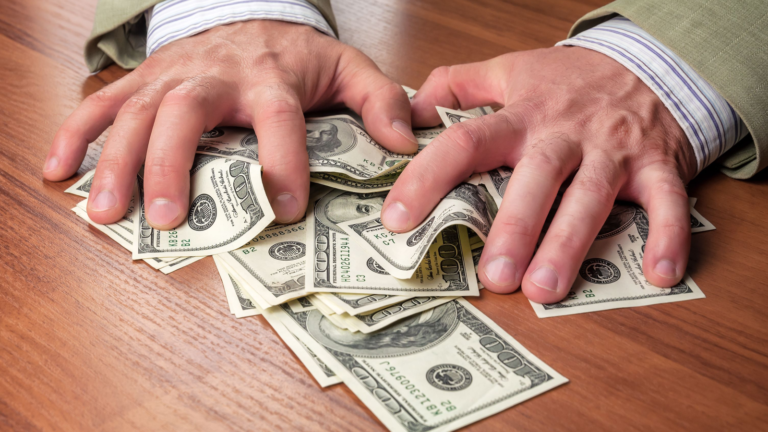“Greedflation” seems to be Wall Street’s favorite trending term lately. Used to describe companies that raised their prices above the scope of supply-side input cost increases, greedflation has, in some ways, become the primary suspect behind elevated prices. With corporate profits on the rise, what exactly is greedflation, and which companies are guilty of feeding into the phenomenon?
Well, greedflation refers to a growing theory that inflation, once considered a result of rising wages, is actually due to a sort of “price-price” spiral in which companies mark up goods notably higher than needed to offset rising production costs. This helps companies to maximize profits.
In March, Paul Donovan, chief economist at UBS Global Wealth Management, released a missive arguing that, especially in late 2022, many retailers and consumer goods makers went out of their way to justify their rate hikes to customers, due to “this terrible war or the pandemic or labor shortages or whatever,” Donovan told Axios. This has fueled an alternative name for the trend: “excuseflation.”
Federal Reserve Vice Chair Lael Brainard further validated the phenomenon in January, when she pointed to corporate markups far beyond the supply-side equivalent as the primary driver of elevated prices.
This mirrors statements from European Central Bank economists, who claimed profit protection was a more impactful driver of inflation than rising wages in the latter half of 2022.
Is Greedflation Real?
While some argue the notion of greedflation is more hysteria than reality, it’s hard to deny the mounting evidence in favor of this theory.
Corporate profit margins hit a 70-year peak in 2022 despite plenty of supply turbulence and the highest inflation since the 1980s. Clearly some companies priced in higher profits while attempting to compensate for black-swan events like the pandemic or Russia’s invasion of Ukraine.
It seems a growing number of Americans are also becoming privy to the trendy term. In a recent survey of 2,000 U.S. consumers, 53% of participants claimed they believe greedflation is happening “a lot.”
Not everyone is on board with the theory, however. Just last week, former Fed Chair Ben Bernanke and French economist Olivier Blanchard, who served as chief economist of the International Monetary Fund (IMF) from 2008 until 2015, released a study theorizing that Covid-19 supply shocks and excessive government stimulus payments were the major culprits behind inflation. Treasury Secretary Janet Yellen made similar claims last year.
Meanwhile, Jon Sindreu argues in the Wall Street Journal that not only is greedflation real, but that it’s likely a net positive for the economy.
With that in mind, what are some examples of greedflation we can see in 2023?
3 Examples of Greedflation in 2023
1. Eggs
Eggs remain a point of controversy among economists and grocery shoppers alike. While egg prices have fallen in recent months, the popular breakfast food jumped 60% in 2022. This has resulted in some egg suppliers accused of fowl play (get it?).
Farm Action, a farmer-led advocacy organization, has accused the biggest egg producers of engaging in a “collusive scheme” to gouge egg prices. It wrote in a letter to the Federal Trade Commission:
“In the end, what Cal-Maine Foods and the other large egg producers did last year — and seem to be intent on doing again this year — is extort billions of dollars from the pockets of ordinary Americans through what amounts to a tax on a staple we all need: eggs. They did so without any legitimate business justification. They did so because there is no ‘reasonable substitute’ for a carton of eggs. They did so because they had power and weren’t afraid to use it.”
2. Cars
The automobile industry is another prime example of greedflation. According to an Edmunds press release from last year, 82% of car buyers paid more than MSRP in January 2022, compared to only 3% in 2021 and almost 0% in January 2020.
While there is an explanation rooted in the short supply of computer chips and car parts, some believe that isn’t the true cause of the markups. Indeed, manufacturers have allegedly barely changed the price of cars delivered to dealerships. Rather, dealerships have hiked prices in the face of skyrocketing demand.
Some carmakers, like Ford (NYSE:F) and General Motors (NYSE:GM), have even sent letters to their dealerships asking them not to elevate prices too far in excess of MSRP.
3. Lysol
Last on the list may come as a surprise: Lysol. Distributors have apparently hiked the cost of the crucial cleaning products to the point of legal intervention.
Just this week, Quality King Distributors was found guilty of substantially raising the price of Lysol products at the peak of the Covid-19 pandemic. The distributor hiked the price of necessary Lysol goods as much as 5% at retailers across New York City and Long Island, despite being epicenters of the pandemic. Quality King now owes $100,000 to New York state after coming out on the losing end of a lawsuit against the company.
On the date of publication, Shrey Dua did not hold (either directly or indirectly) any positions in the securities mentioned in this article. The opinions expressed in this article are those of the writer, subject to the InvestorPlace.com Publishing Guidelines.

